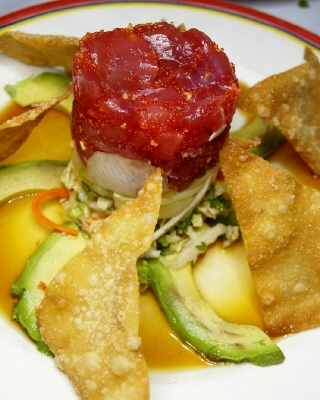
Yellowfin Tuna
Fresh tuna went from unavailable to a favorite hereabouts in just a few years, in the early 1980s. Once it did, it became hard to imagine a time when, if you said tuna, you meant tuna from a can. The fresh was just not available. (We had no sushi bars then, either.)
Tuna is unlike most other fish we eat in this area. It's never seen in fillet form--always in steaks. It's not white, it's shades of deep red. It has the texture of meat, with flakes so big that sometimes a large piece of the fish shows no flake structure at all.
Yellowfin tuna--also known as "ahi"--is the most common kind we get from the Gulf. (Bluefin will turn up higher up this list.) When you see it in stores, it's often marked "sushi grade." There is no official sushi grade, and you can ignore that.
 Tuna cookery calls for different rules. It's certainly the fish that's most often eaten not cooked at all, or nearly raw. The first raw fish people learn to appreciate in sushi bars is tuna. Something about it makes the raw-fish experience easier to accept.
Tuna cookery calls for different rules. It's certainly the fish that's most often eaten not cooked at all, or nearly raw. The first raw fish people learn to appreciate in sushi bars is tuna. Something about it makes the raw-fish experience easier to accept.
The greatest truth ever uttered on the subject of cooking tuna came from Chef Paul Prudhomme. During a legislative hearing on the disappearance of redfish in the early 1980s, chefs were being blamed for the overfishing of redfish. Chef Paul pointed out that there is a much better fish to blacken than redfish: tuna.
He's right. Nothing's better blackened than tuna, and no way of cooking tuna is better than blackening it. What comes out is something that looks likes, feels like, and almost tastes like a beefsteak.
Which is the key to tuna, in my mind. You don't cook it like fish, you cook it like meat. If there's a style of cooking or a sauce that would go well with a steak, it probably will work for tuna, as well. Even offbeat ideas, like tartare, are great with tuna.
It seems to me that the quality of tuna in restaurants these days is better than it once was--and worse. I'm encountering tuna here and there that's cut from the tougher parts of the fish, toward the rear. This is especially unsavory when the fish is serves sashimi-style.
I'd like to make a suggestion to chefs who cook tuna. Instead of cutting it into the four-by-six-inch steaks three-quarters of an inch thick, how about reducing the width and increasing the thickness? The best tuna dishes I ever had involved what amounted to blocks, rather than slices, of tuna.